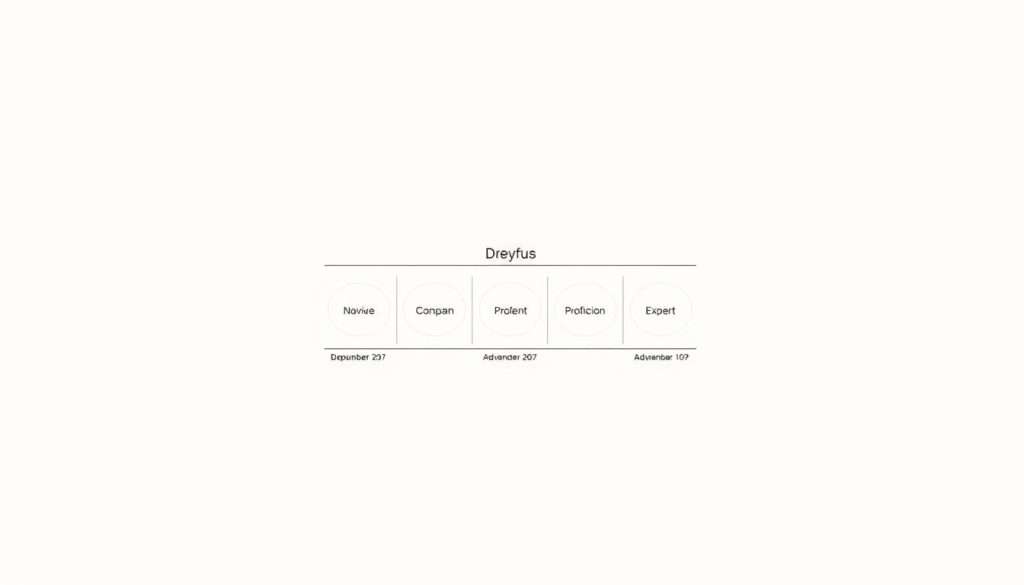Are you ready to unlock the secrets of becoming an expert in any field? The journey from novice to master is not easy. But with the right framework, you can navigate it with ease. We’re excited to introduce you to a powerful tool that will help you understand the process of skill acquisition.
The Dreyfus model is a framework that describes how we progress from being a beginner to an expert. It’s a simple yet effective way to understand the stages involved in developing a new skill. In this primer, we’ll explore the origins of this model, its applications, and how you can apply it to your learning journey.
Key Takeaways
- Understand the Dreyfus model and its role in skill development.
- Learn the stages involved in progressing from a novice to an expert.
- Discover how to apply the model to your learning journey.
- Explore the origins and applications of the Dreyfus model.
- Gain insights into becoming an expert in any field.
What is the Dreyfus Model?
The Dreyfus model starts with its history and the brothers who made it. The Dreyfus model, created by Stuart and Hubert Dreyfus, shows how people learn skills. It explains how they move from beginners to experts.
The Dreyfus model comes from the brothers’ deep research on learning skills. The ACGME says the six Core Competencies were based on the Dreyfus model. This shows how important the model is for learning and growing.
Origins and Development
The Dreyfus brothers were pioneers in studying skill learning. Their work found different stages in skill development. This model is used in many fields, like education and healthcare.
“The Dreyfus model gives a detailed look at how skills are learned and how people move through different levels of skill.” This knowledge has helped shape how we teach and test skills.
The Dreyfus Brothers’ Background
Stuart and Hubert Dreyfus, known for their work together, brought a special view to studying skills. Their background in philosophy and cognitive science helped their research. Their work has greatly influenced how we see learning and growth.
Knowing about the Dreyfus brothers model and its beginnings helps us see its value today.
The Five Stages of the Dreyfus Model
Let’s explore the five stages of the Dreyfus model. This framework changes how we learn and grow. As we move through these stages, our skills improve, and we become more confident.
Novice Stage
The novice stage is where most of us start. At this point, we heavily rely on rules and guidelines to do tasks.
Characteristics and Behaviors
Novices stick to instructions closely. They might struggle with new situations. They need a lot of supervision and feedback to get better.
Advanced Beginner Stage
As we gain more experience, we enter the advanced beginner stage. Here, we start to understand tasks better.
Characteristics and Behaviors
Advanced beginners can apply their knowledge in different ways. They start to see patterns. But, they still need guidance and might not fully understand the task.
Competent Stage
At the competent stage, we make informed decisions. We can prioritize tasks and manage our time well.
Characteristics and Behaviors
Competent individuals are more independent. They can handle complex tasks. They see how their actions affect overall performance.
Proficient Stage
The proficient stage is a big leap. Learners start to understand and handle situations intuitively.
Characteristics and Behaviors
Proficient learners have a strong intuition. They can often figure out what needs to be done without analyzing every detail. They adapt well to unexpected challenges.
Expert Stage
The expert stage is the highest level of skill. Experts have a deep understanding of their field.
Characteristics and Behaviors
Experts handle complex situations easily. They often innovate in their field. They are trusted sources of knowledge and can mentor others.
To show how we progress through these stages, here’s a table:
| Stage | Key Characteristics | Typical Behaviors |
|---|---|---|
| Novice | Reliance on rules, limited understanding | Follows instructions rigidly, seeks constant feedback |
| Advanced Beginner | Gaining experience, starting to apply knowledge | Recognizes patterns, still seeks guidance |
| Competent | Informed decision-making, prioritization | Manages time effectively, handles complex tasks |
| Proficient | Intuitive understanding, adaptability | Handles unexpected challenges, acts with intuition |
| Expert | Deep, intuitive understanding, innovation | Authoritative, mentors others, innovates |
Key Principles of the Dreyfus Model
The Dreyfus model is based on a few key principles. It was created by Stuart and Hubert Dreyfus. They say skill learning is more than just following rules. It’s about really understanding the situation where we use those skills.
Decision-Making Processes
The Dreyfus model focuses a lot on how we make decisions. As we get better, our decisions become more instinctive. We don’t think as much.
For example, a new driver might check a list to make sure they do everything right. But an experienced driver knows what to do without thinking about it. This is because they’ve practiced a lot.
Stuart Dreyfus says, “The proficient performer, seeing the situation as a whole, uses maxims, which are guidelines that dictate or suggest specific actions.” This shows how important experience and understanding the situation are in making good decisions.
Perception and Context Recognition
Another important part of the Dreyfus model is how we see and understand situations. As we get better, we can spot important things in a situation and know what’s going on. It’s not just about seeing patterns. It’s about knowing the small details too.
For example, a top chef can look at a kitchen and know exactly what’s needed to finish a dish. This comes from years of experience and understanding the situation well.
The Dreyfus model teaches us that getting good at something is all about seeing and understanding the situation. By working on these skills, we can become experts in what we do.
The Progression Path in Skill Acquisition
The Dreyfus model shows a clear path for learning new skills. But what does this journey look like? As we move from beginner to expert, knowing the path is key to learning well.
Transitioning Between Stages
Moving between the Dreyfus model’s stages isn’t always straightforward. You might go back and forth as you face new challenges or see things in a new light. For example, moving from beginner to advanced beginner means using what you’ve learned in real life. This step can be helped by practical experience and feedback.
| Stage | Key Characteristics | Transition Tips |
|---|---|---|
| Novice | Relies on rules, doesn’t fully understand context | Practice with guidance, get feedback |
| Advanced Beginner | Starts to see the bigger picture, still follows guidelines closely | Try more complex tasks, think about your experiences |
| Competent | Feels responsible, can solve problems | Take on more tasks, learn from mistakes |
Common Challenges and Plateaus
As you move forward, you’ll hit challenges and plateaus. Spotting these obstacles is the first step to beating them. Common issues include feeling stuck or struggling to use skills in new ways. To get past these, thinking about your learning and trying different things can help.
Knowing that progress isn’t always smooth and that obstacles are part of the journey keeps you motivated. By understanding the path and its challenges, you’re ready to tackle your learning journey.
The Dreyfus Model in Education
Education can get a big boost from the Dreyfus model. It helps schools improve how they teach and check student progress. This model shows how students move from beginners to experts, helping teachers tailor their lessons.
The Dreyfus model gives a clear way to learn new skills. It’s great for schools because it shows the different learning stages students go through.
Application in Teaching Methodologies
The Dreyfus model changes how teachers teach. Novice students need clear instructions, while experts can handle more complex tasks. Teachers can adjust their methods to fit each student’s level, making learning better.
Student Assessment Through the Dreyfus Lens
Assessing students is easier with the Dreyfus model. Teachers can see where each student stands. This way of checking progress gives students better feedback and helps them learn faster.
With the Dreyfus model, teachers can spot where students need help. This targeted support boosts student success.
The Dreyfus Model in Nursing and Healthcare
The Dreyfus model has changed nursing and healthcare a lot. It gives a way to grow skills and make patient care better. It helps people see how they move from being new to being an expert, helping with training and growth.

Nursing Skill Development Framework
The Dreyfus model gives a clear way to grow nursing skills. It lets professionals check where they are and what they need to get better. Nurses can make plans to improve based on the model’s five stages.
Patient Care Quality Improvement
Healthcare groups can make patient care better by using the Dreyfus model. As nurses get better, they can handle more complex patient needs. This leads to better results for patients.
The Dreyfus model is very useful in nursing and healthcare. It helps grow skills and improve patient care. By using it, professionals can give better care and make patients’ lives better.
The Dreyfus Model in Business and Management
The Dreyfus model gives a fresh view on how skills grow in business and management. It shows how people learn skills. This helps companies make better training and boost performance.
This model shows how people go from beginners to experts. It’s useful in many business areas. It helps find out what employees are good at and what they need to work on.
Employee Development Programs
Employee development is key for companies wanting to improve their team. The Dreyfus model helps in several ways:
- It lets companies make training that fits each employee’s level.
- It helps spot and train future leaders.
- It keeps employees happy and helps them grow in their careers.
Leadership Skill Progression
The Dreyfus model also helps in growing leadership skills. It shows how leaders can improve their abilities:
- They can get better at their job, from good to great.
- They can guide their team better, based on each member’s level.
- They can make smarter choices, using their experience and gut feeling.
Using the Dreyfus model, companies can create a culture of learning and growth. This leads to lasting success.
The Dreyfus Model in Artificial Intelligence
The Dreyfus model is interesting when we talk about how humans learn and AI grows. It shows how AI goes from being new to being very good. This is like how humans learn new things.
Parallels to Machine Learning
Machine learning is a part of AI that gets better at doing tasks. The Dreyfus model’s stages are similar to how machine learning grows. A machine starts by learning from data, then gets better with practice. It keeps getting better until it’s very good.
- Novice: Initial training with limited understanding
- Advanced Beginner: Recognizes patterns, starts to apply learned rules
- Competent: Makes decisions based on context, handles more complex situations
- Proficient: Intuitively responds to situations, adapts to new information
- Expert: Performs tasks with high accuracy and speed, often surpassing human capabilities
Limitations in AI Skill Acquisition
Even though the Dreyfus model is helpful, using it for AI has its own problems. AI doesn’t think like humans do. It uses data and rules instead of experience. Also, AI learning is different from how humans learn.
Knowing these similarities and differences helps us make AI better. We can use what’s good about both human and machine learning.
Criticisms and Limitations of the Dreyfus Model
The Dreyfus Model has been widely used but also faced many criticisms. It’s important to look at both the theoretical and practical issues raised.
Theoretical Challenges
Many have said the Dreyfus Model oversimplifies how we learn new skills. They argue its five stages don’t fully capture the complexity of learning in different areas. Also, the idea of a linear progression is questioned, as real learning often takes non-linear paths.
- The model’s stages may not fit all skills and situations.
- Some say it doesn’t consider the impact of innate talent or motivation on learning.
Practical Implementation Issues
Putting the Dreyfus Model into practice is hard. Figuring out someone’s skill level can be very subjective. The model’s stages don’t offer clear goals for moving forward.
- It’s hard to accurately judge someone’s skill level.
- There’s little help on how to help someone move to the next stage.

By knowing these criticisms, we can see the complexity of learning new skills. We understand the need for more detailed approaches to learning and growth.
Modern Adaptations and Extensions of the Dreyfus Model
Researchers and practitioners have made many changes to the Dreyfus model. These updates make the model useful in many areas today. They help us understand skill development better.
Seven-Stage Models
One big change is adding two more stages to the original five. This makes the model more detailed. It helps us track skill growth, even in complex areas.
| Stage | Description |
|---|---|
| Novice | Initial stage of skill acquisition |
| Advanced Beginner | Demonstrates a basic understanding |
| Competent | Shows a significant improvement in skill |
| Proficient | Exhibits a high level of proficiency |
| Expert | Mastery of the skill |
| Master | Exceptional skill and innovation |
| Visionary | Transcends existing boundaries |
Domain-Specific Variations
Another key change is making the Dreyfus model fit specific areas. This makes it more useful for each field’s unique needs. For example, there are versions for nursing, business, and artificial intelligence.
These updates show the Dreyfus model’s ongoing value. By using these new versions, experts can improve skills in their fields.
How to Apply the Dreyfus Model in Your Learning Journey
Using the Dreyfus model helps you manage your learning and skills. It offers a clear path to grow from one skill level to the next. To use it well, you must learn how to assess yourself and make plans for your growth.
Self-Assessment Techniques
Self-assessment is key to knowing where you stand in the Dreyfus model. Reflecting on your experiences and honestly evaluating your abilities are crucial steps. To figure out your stage, ask yourself:
- How do I approach challenges in my learning journey?
- Can I apply what I’ve learned in new contexts?
- How do I handle uncertainty or unexpected situations?
Identifying Your Current Stage
By answering these questions, you can see if you’re a novice, advanced beginner, competent, proficient, or expert.
Creating Personal Development Plans
After knowing your stage, you can make a plan for your growth. Setting stage-appropriate goals is key to moving forward.
Setting Stage-Appropriate Goals
If you’re a novice, your goal might be to get more experience and build confidence. As you get better, your goals will change. They will focus on improving your skills and understanding the subject better.
Hubert and Stuart Dreyfus said, “The expert has a deep understanding of the skill, with an intuitive grasp of the situation.” By using the Dreyfus model and setting the right goals, you can aim for this level of expertise.
Conclusion
We’ve looked into the Dreyfus model, a way to understand how we learn and grow. It shows five stages: novice, advanced beginner, competent, proficient, and expert. Knowing these stages helps us on our learning path.
The Dreyfus model teaches us about making decisions, seeing things clearly, and understanding situations. It’s used in many areas like education, nursing, business, and AI.
Now that we’ve learned about the Dreyfus model, we can plan our skill growth better. We can see where we are and where we’re going. This helps us make good plans for improving ourselves.
In summary, the Dreyfus model is a key tool for learning. It helps us learn better and reach our goals. It shows us how to keep moving forward in our skill development.

